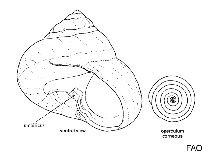Umbonium elegans (Kiener, 1838)
Warning: DOMDocument::load(): SSL operation failed with code 1. OpenSSL Error messages: error:140770FC:SSL routines:SSL23_GET_SERVER_HELLO:unknown protocol in C:\Apache24\htdocs\includes\SpeciesSummary.lib.php on line 1236
Warning: DOMDocument::load(): Failed to enable crypto in C:\Apache24\htdocs\includes\SpeciesSummary.lib.php on line 1236
Warning: DOMDocument::load(https://sealifebase.nrm.se/webservice/AquaMaps/getAMap.php?genus=Umbonium&species=elegans): failed to open stream: operation failed in C:\Apache24\htdocs\includes\SpeciesSummary.lib.php on line 1236
Warning: DOMDocument::load(): I/O warning : failed to load external entity "https://sealifebase.nrm.se/webservice/AquaMaps/getAMap.php?genus=Umbonium&species=elegans" in C:\Apache24\htdocs\includes\SpeciesSummary.lib.php on line 1236
Mandar um arquivo com seu (sua) Fotos
Imagem do Google | No image available for this species;
drawing shows typical species in Trochidae.
Imagem do Google | No image available for this species;
drawing shows typical species in Trochidae.
Classification / Names Common names | Synonyms | CoL | ITIS | WoRMS
| Trochida | Trochidae
Environment: milieu / climate zone / depth range / distribution range Ecologia
. Tropical
Distribuição Países | Áreas FAO | Ecossistemas | Ocorrências | Introduções
Western Central Pacific: Philippines.
Length at first maturity / Tamanho / Peso / Idade
Maturity: Lm ? range ? - ? cm Max length : 1.8 cm SHD macho/indeterminado; (Ref. 821)
Descrição suscinta Morfologia
Shell is small, discoidal, with a moderately tall straight-sided spire and a white, strongly convex umbilical button. Whorl surfaces are smooth with obsolete spiral and arcuate axial scratches and a weak concave trough below the body whorl suture. Aperture is elongate and smooth within. Whorl surfaces has black quadrangular dots in spiral lines, a black subsutural band and a black and cream-striped periphery.
Life cycle and mating behavior Maturidade | Reprodução | Desova | Ovos | Fecundidade | Larvas
Members of the order Archaeogastropoda are mostly gonochoric and broadcast spawners. Life cycle: Embryos develop into planktonic trocophore larvae and later into juvenile veligers before becoming fully grown adults.
Referência principal
Referências | Coordenador | Colaboradores
Springsteen, F.J. and F.M. Leobrera. 1986. (Ref. 821)
Status na Lista Vermelha da IUCN (Ref. 130435)
Status no CITES (Ref. 108899)
Not Evaluated
CMS (Ref. 116361)
Not Evaluated
Perigo para os humanos
Uso pelos humanos
| FishSource |
Ferramentas
Mais informação
Fontes da internet
BHL | BOLD Systems | CISTI | DiscoverLife | FAO(Publication : search) | Fishipedia | GenBank (genoma, nucleotídeo) | GloBI | Gomexsi | Google Books | Google Scholar | Google | PubMed | Árvore da vida | Wikipedia (Ir para, procura) | Registro zoológico



